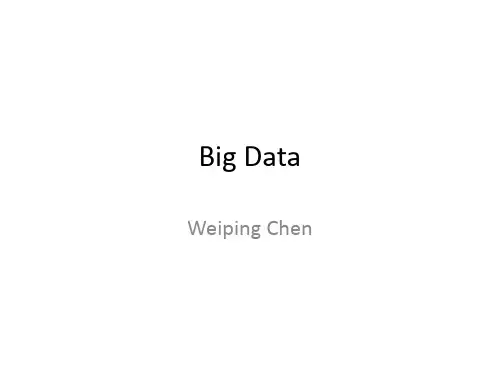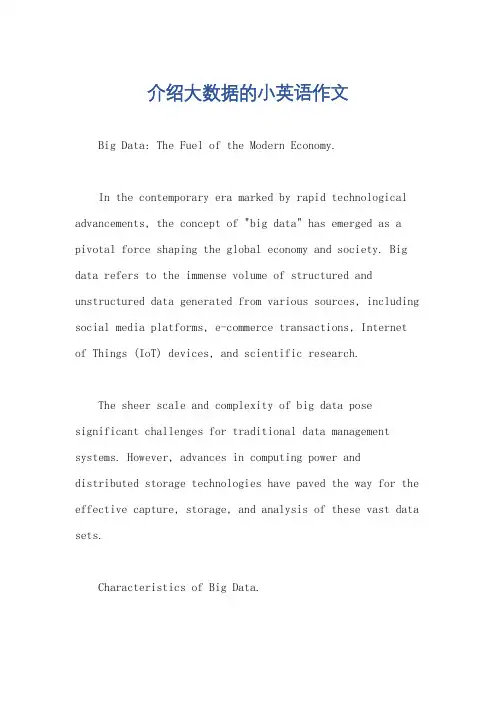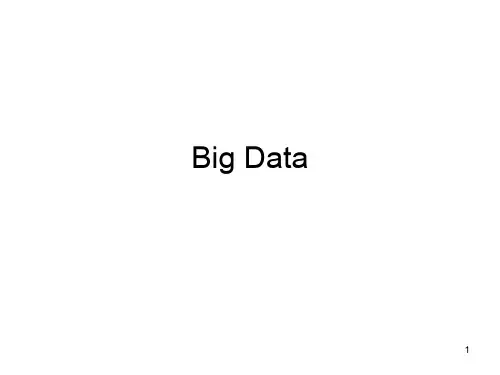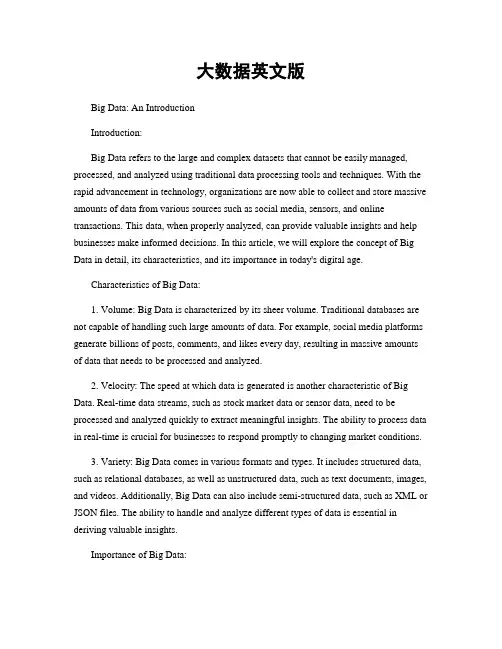A Brief Introduction of Big Data 大数据PPT
- 格式:ppt
- 大小:4.21 MB
- 文档页数:16


介绍大数据的小英语作文Big Data: The Fuel of the Modern Economy.In the contemporary era marked by rapid technological advancements, the concept of "big data" has emerged as a pivotal force shaping the global economy and society. Big data refers to the immense volume of structured and unstructured data generated from various sources, including social media platforms, e-commerce transactions, Internet of Things (IoT) devices, and scientific research.The sheer scale and complexity of big data pose significant challenges for traditional data management systems. However, advances in computing power and distributed storage technologies have paved the way for the effective capture, storage, and analysis of these vast data sets.Characteristics of Big Data.Big data is characterized by its unique attributes known as the "four Vs":Volume: Big data encompasses massive amounts of data, measured in terabytes, petabytes, or even exabytes.Variety: It includes data from diverse sources and formats, such as text, images, videos, audio, and sensor readings.Velocity: Big data is generated and processed at an unprecedented speed, requiring real-time or near-real-time analysis.Veracity: The quality and accuracy of big data can vary significantly, necessitating data cleaning and verification processes.Benefits of Big Data.Harnessing the power of big data offers numerous benefits across various domains:Improved Decision-Making: Big data provides businesses and organizations with valuable insights into customer behavior, industry trends, and operational efficiency. By analyzing large data sets, they can make informed decisions based on data-driven evidence.Personalized Experiences: Big data enables tailored products, services, and marketing campaigns by identifying individual preferences and behaviors. This personalization enhances customer satisfaction and loyalty.Operational Optimization: Industries such as manufacturing, transportation, and healthcare leverage big data to optimize operations, reduce costs, and improve productivity.Scientific Discovery: Big data plays a crucial role in scientific research, facilitating the analysis of complex phenomena and unlocking new knowledge in fields such as genomics, climate science, and astrophysics.Social Good: Big data has the potential to address societal challenges, such as improving healthcare outcomes, promoting education, and reducing crime.Challenges of Big Data.While big data offers immense benefits, it also presents challenges that must be addressed:Data Security and Privacy: The vast amount ofsensitive data collected and stored poses risks of data breaches and misuse, which require robust security measures and ethical considerations.Data Management and Analysis: The scale and complexity of big data require specialized tools and skills for efficient data management, analysis, and visualization.Data Governance: Organizations need to establish data governance frameworks to ensure data quality, consistency, and accessibility while mitigating risks.Ethical Implications: The use of big data raises ethical concerns related to privacy, discrimination, and the potential for manipulative practices.Conclusion.Big data is transforming the way we live, work, and interact with the world. By leveraging the vast amounts of data generated in the digital age, organizations and individuals can gain unprecedented insights, optimize operations, and drive innovation. However, it is crucial to address the challenges associated with big data while ensuring ethical and responsible data management practices to harness its full potential for the benefit of society.。



![[课件]BigData数据大爆炸PPT](https://uimg.taocdn.com/fcd8152df12d2af90242e64f.webp)

大数据英文版Big Data: An IntroductionIntroduction:Big Data refers to the large and complex datasets that cannot be easily managed, processed, and analyzed using traditional data processing tools and techniques. With the rapid advancement in technology, organizations are now able to collect and store massive amounts of data from various sources such as social media, sensors, and online transactions. This data, when properly analyzed, can provide valuable insights and help businesses make informed decisions. In this article, we will explore the concept of Big Data in detail, its characteristics, and its importance in today's digital age.Characteristics of Big Data:1. Volume: Big Data is characterized by its sheer volume. Traditional databases are not capable of handling such large amounts of data. For example, social media platforms generate billions of posts, comments, and likes every day, resulting in massive amounts of data that needs to be processed and analyzed.2. Velocity: The speed at which data is generated is another characteristic of Big Data. Real-time data streams, such as stock market data or sensor data, need to be processed and analyzed quickly to extract meaningful insights. The ability to process data in real-time is crucial for businesses to respond promptly to changing market conditions.3. Variety: Big Data comes in various formats and types. It includes structured data, such as relational databases, as well as unstructured data, such as text documents, images, and videos. Additionally, Big Data can also include semi-structured data, such as XML or JSON files. The ability to handle and analyze different types of data is essential in deriving valuable insights.Importance of Big Data:1. Decision Making: Big Data analytics enables organizations to make data-driven decisions. By analyzing large datasets, businesses can identify patterns, trends, and correlations that can help them understand customer behavior, optimize operations, and develop targeted marketing strategies. For example, an e-commerce company can use Big Data analytics to analyze customer browsing patterns and preferences to offer personalized product recommendations.2. Innovation: Big Data has the potential to drive innovation in various industries. By analyzing large datasets, businesses can identify new market opportunities, develop innovative products and services, and improve existing processes. For instance, healthcare organizations can leverage Big Data analytics to identify disease patterns, predict outbreaks, and develop effective treatment plans.3. Cost Reduction: Big Data technologies can help organizations reduce costs and improve efficiency. By analyzing data from various sources, businesses can identify areas of wastage, optimize resource allocation, and streamline operations. For example, logistics companies can use Big Data analytics to optimize their delivery routes, reduce fuel consumption, and improve overall operational efficiency.Challenges of Big Data:1. Data Privacy and Security: With the increasing amount of data being collected, data privacy and security have become major concerns. Organizations need to ensure that they have robust security measures in place to protect sensitive data from unauthorized access or breaches. Additionally, they must comply with relevant data protection regulations and ensure that customer data is handled responsibly.2. Data Quality: The quality of data is crucial for accurate analysis and decision-making. Big Data often comes from various sources and may contain errors, inconsistencies, or missing values. Data cleansing and preprocessing techniques are necessary to ensure that the data is accurate, complete, and reliable.3. Skills and Expertise: Analyzing Big Data requires a specialized skill set. Data scientists and analysts need to have a deep understanding of statistical analysis, machinelearning, and data visualization techniques. Organizations need to invest in training and hiring skilled professionals to effectively leverage Big Data.Conclusion:Big Data has revolutionized the way organizations operate and make decisions. The ability to collect, store, and analyze massive amounts of data has opened up new possibilities for businesses across various industries. By harnessing the power of Big Data analytics, organizations can gain valuable insights, drive innovation, and improve operational efficiency. However, it is important to address the challenges associated with Big Data, such as data privacy and security, data quality, and the need for skilled professionals.。


Big Data大数据技术交流目录❖1.大数据技术介绍❖2.Hadoop(HDFS,MapReduce)介绍❖3.Hadoop的最新发展❖4.流计算技术❖5.内存数据库❖6.列式数据库❖7.各技术适用的场合❖8.讨论什么是大数据?大数据指的是海量无法通过传统方式管理的数据。
Big Data作为一个专有名词成为热点,主要应归功于近年来互联网、云计算、移动和物联网的迅猛发展。
无所不在的移动设备、RFID、无线传感器每分每秒都在产生数据,数以亿计用户的互联网服务时时刻刻在产生巨量的交互……要处理的数据量实在是太大、增长太快了,而业务需求和竞争压力对数据处理的实时性、有效性又提出了更高要求,传统的常规技术手段根本无法应付。
大数据的4V 特性多样性Variety 速度Velocity 非结构化数据的超大规模和增长总数据量的80~90%比结构化数据增长快10倍到50倍是传统数据仓库的10倍到50倍大数据的异构和多样性很多不同形式(文本、图像、视频、机器数据)无模式或者模式不明显不连贯的语法或句义大量的不相关信息对未来趋势与模式的可预测分析深度复杂分析(机器学习、人工智能Vs传统商务智能(咨询、报告等)实时分析而非批量式分析数据输入、处理与丢弃立竿见影而非事后见效大数据技术分布式缓存、基于MPP 的分布式数据库、分布式文件系统、各种NoSQL 分布式存储方案,内存数据库等。
存储处理应用Map Reduce ,流计算HIVE,pig,R ,mahout 等查询统计,数据挖掘技术❖大数据的存储❖采用了一批新技术,主要包括分布式缓存、基于MPP的分布式数据库、分布式文件系统、各种NoSQL分布式存储方案等。
分布式数据库与传统数据库对比大规模并行处理MPP (Massively Parallel Processing)。


BigData大数据介绍全英Introduction to Big DataBig Data is a term that refers to large and complex sets of data that cannot be easily managed or processed using traditional data processing techniques. With the advancement of technology and the rapid growth of the internet, the amount of data being generated has skyrocketed. This data comes from various sources such as social media, sensors, online transactions, and more. Big Data has become a crucial part of many industries, offering valuable insights and opportunities for businesses and organizations.1. Definition of Big DataBig Data is characterized by three distinct aspects, commonly known as the three Vs: Volume, Velocity, and Variety. First, Volume refers to the massive amount of data being generated, which often exceeds the capabilities of traditional database systems. Second, Velocity relates to the speed at which data is generated and the need to analyze it in real-time or near real-time. Lastly, Variety refers to the diverse types and formats of data, including structured, unstructured, and semi-structured data.2. Importance of Big DataBig Data has the potential to revolutionize industries and decision-making processes. By analyzing and interpreting this wealth of data, businesses can gain valuable insights that can drive innovation, improve operational efficiency, enhance customer experiences, and boost overall performance. For example, retailers can analyze customer purchase patternsto optimize inventory management, while healthcare providers can leverage Big Data to improve patient care and outcomes.3. Applications of Big DataBig Data finds its application across various sectors, including but not limited to:3.1. Marketing and Advertising: Big Data enables marketers to understand consumer behavior, target specific demographics, and personalize advertisements, leading to improved campaign effectiveness and customer engagement.3.2. Healthcare: Analysis of large datasets can identify disease patterns, track outbreaks, and improve patient care through predictive analytics and personalized medicine.3.3. Finance: Financial institutions can utilize Big Data to detect fraudulent activities, assess credit risks, and make more accurate predictions for investments.3.4. Transportation and Logistics: Big Data helps optimize route planning, supply chain management, and fleet efficiency, leading to cost savings and improved delivery times.4. Challenges and ConcernsWhile the benefits of Big Data are substantial, there are also challenges associated with its implementation. Some of the key challenges include:4.1. Data Privacy and Security: As more personal and sensitive data is collected, protecting privacy and ensuring security becomes a criticalconcern. Robust data protection measures are required to safeguard information and ensure compliance with relevant regulations.4.2. Data Quality and Integration: Ensuring the accuracy, reliability, and consistency of Big Data from various sources can be challenging. Proper data integration and preprocessing techniques are essential to obtain meaningful insights.4.3. Skill Gap: The field of Big Data requires individuals with a strong understanding of data analytics, statistics, programming, and business domain knowledge. Addressing the shortage of skilled professionals is vital for successful implementation.5. Future TrendsThe future of Big Data is promising, with continuous advancements in technology and data analytics. Some emerging trends include:5.1. Artificial Intelligence and Machine Learning: AI and ML techniques are being employed to analyze and extract meaningful insights from Big Data, leading to automation, predictive analytics, and improved decision-making processes.5.2. Internet of Things (IoT): The proliferation of IoT devices generates vast amounts of data, contributing to the growth of Big Data. The integration of IoT and Big Data offers opportunities for valuable insights and enhanced connectivity.5.3. Cloud Computing: Cloud-based platforms provide scalable infrastructure and storage capabilities for Big Data analysis, enablingbusinesses of all sizes to leverage its benefits without significant upfront investments.ConclusionBig Data has transformed the way organizations operate and make decisions. Its ability to provide valuable insights and predictive analytics empowers businesses to stay competitive in a rapidly evolving digital landscape. By harnessing the power of Big Data, businesses can unlock opportunities for growth, innovation, and improved performance across various industries.。
big data 英语作文Big data is everywhere. It's in the emails we send, the social media we use, the online purchases we make, and even in the way we navigate our cities. It's the massive amount of information that is being generated every second of every day, and it's changing the way we live and work.With big data, companies can analyze massive amounts of information to gain insights into customer behavior, market trends, and operational efficiency. This allows them to make better decisions, improve their products and services, and ultimately, increase their bottom line.But big data is not without its challenges. Privacy concerns have become a major issue, as companies and governments collect and analyze personal data without the consent of individuals. There are also concerns about the accuracy and reliability of the data being collected, as well as the potential for misuse and abuse.Despite these challenges, big data has the potential to revolutionize industries and improve the lives of people around the world. From healthcare to transportation to finance, the insights gained from big data can lead tobetter decision-making, improved efficiency, and ultimately, a better world for all of us.。